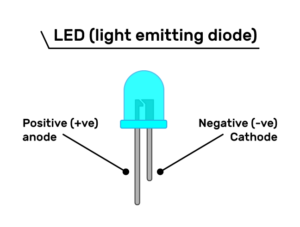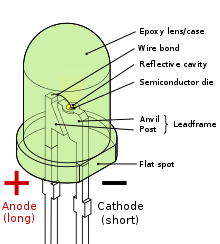The LED full form is Light Emitting Diode.
What is LED?
It is a two-lead semiconductor light source. It is mostly used in electronic test equipment, TVs, calculators, watches, radios, etc. The light emitted by LEDs is both visible (e.g., bulbs and display screens) and invisible to the human eye (e.g., the infrared LEDs used in remote controls of household appliances).

Smartphones, TVs, computers, and many other modern technological miracles have been made possible by power-efficient led screens, but the real impact goes well beyond our brightly lit gadgets.
Lighting accounts for 20-30% of global electricity consumption and about 6% of greenhouse gas emissions. Given that LEDs use around 80%less energy and last 25% longer than incandescent lighting, they have the greatest potential impacts on energy savings globally.
When the first LEDs were introduced in the 1960s, they didn’t have much use. It wasn’t until the 90s that Japanese scientists discovered the blue led, the revolution began to take shape.
Thomas Edison invented the light bulb in 1879; incandescent lights lit much of the 20th century. The problems with these were a lot of energy was lost in the form of heat, and they did not last long. Then came the era of more efficient fluorescent lights but not an ideal replacement. They contain toxic mercury and are prone to flicker.
How LED Works?
LEDs don’t contain filaments. LEDs are made up of a key ingredient called Gallium Nitride. When a suitable electricity voltage is applied to the leads, electrons recombine with electron holes and release energy in the form of photons. This effect is called electroluminescence. The color of LED’s light is determined by the energy bandgap of the semiconductor.
Light Emitting Diode (full form of the LED) is proved to be a revolutionary product in the field of light sources. Its lamps are very energy efficient, economical, and long-lasting. When compared with conventional bulbs and fluorescent light sources, it is almost 80% energy efficient.

Benefits of LED
- LED requires very little power. For example, LED TVs are more energy-efficient than LCD and CRT TV.
- It produces less heat, so it reduces the cooling loads. Also, it does not produce buzzing noises and flickers, etc.
- LED offers better image quality than LCD.
- LED lights are non-toxic and environment-Friendly. It does not contain mercury, lead, or cadmium. More frequent use of LED lights can reduce carbon emissions.
- With proper installation, the LED can be worked for a long period with a very low maintenance cost. It also requires a very low recycling charge.
- LED is recyclable with low recycling charges.
Conclusion
The LED full form is Light Emitting Diode. It is a two-lead semiconductor light source used in electronic test equipment, TVs, calculators, watches, radios, etc.
LED requires very little power, offers better image quality, lights are non-toxic, and is environment friendly.
Here in this post, we discussed the full form of LED, benefits, how it works, and more in detail.
People are also reading:

